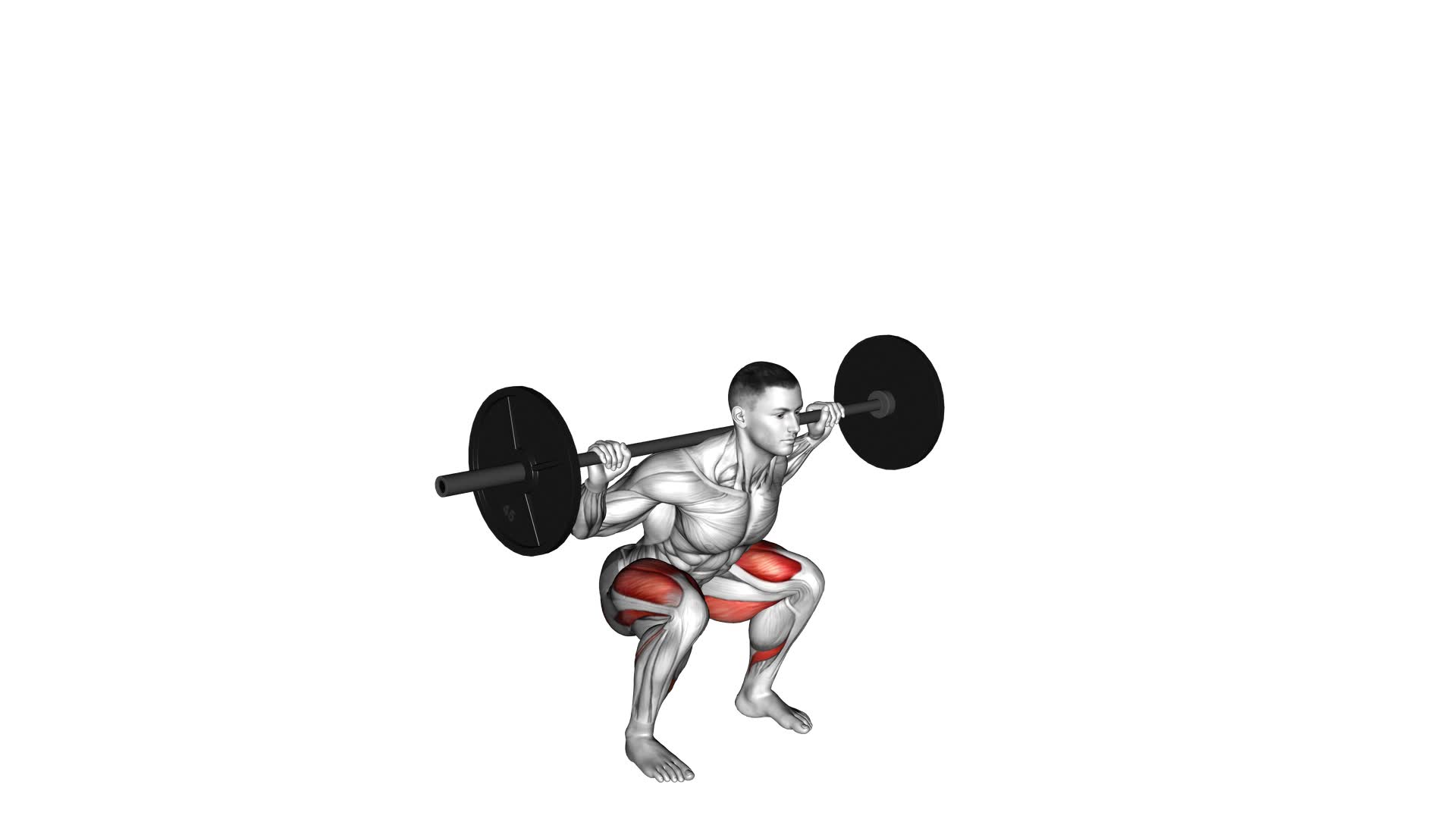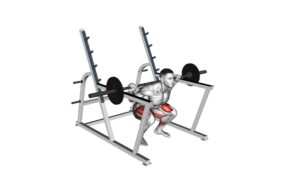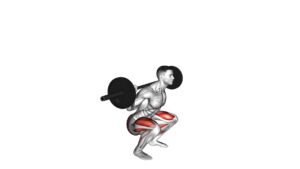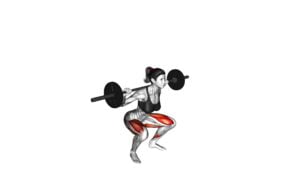Barbell High Bar Squat – Video Exercise Guide & Tips

Are you looking to improve your squat form and increase your strength? Look no further than the Barbell High Bar Squat!
Watch This Exercise Video
In this video exercise guide, we'll show you the proper form, tips for setting up your barbell and rack, and common mistakes to avoid.
Whether you're a beginner or experienced lifter, our tips and techniques will help you maximize your squatting potential.
Get ready to take your squat game to the next level with our expert advice and demonstration.
Key Takeaways
- Proper barbell positioning is crucial for a successful squat
- Optimal foot placement and stance width enhance squat performance and minimize the risk of injury
- Proper alignment improves stability, efficiency, and reduces the risk of injury
- Engaging core muscles, maintaining a neutral spine, and pushing through the heels are key elements of executing the squat movement effectively.
Proper Barbell High Bar Squat Form
To perform the barbell high bar squat correctly, position the barbell across your upper back and shoulders, ensuring your feet are shoulder-width apart. This exercise offers a range of benefits for your lower body strength and overall fitness. One of the key benefits is that it targets multiple muscle groups simultaneously, including the quadriceps, hamstrings, glutes, and calves. Additionally, the high bar position places more emphasis on the quadriceps, making it a great exercise for building strong and defined legs.
In terms of alternatives, if you're unable to perform the barbell high bar squat due to lack of equipment or physical limitations, there are several variations you can try. The goblet squat is a great alternative that can be done with a dumbbell or kettlebell. This variation still targets the same muscle groups and can be easier on the lower back.
Another alternative is the bodyweight squat, which can be performed anywhere and requires no equipment. While it may not provide the same level of resistance as the barbell high bar squat, it's still an effective exercise for building lower body strength.
Remember to always start with lighter weights and focus on proper form to avoid injury and get the most out of the exercise.
Setting Up Your Barbell and Rack
To properly set up your barbell and rack for the high bar squat, there are a few key points to keep in mind.
First, ensure that the barbell is positioned at the appropriate height on the rack, allowing you to easily lift it onto your shoulders.
Secondly, take necessary safety precautions, such as using collars to secure the weights in place and checking that the rack is stable.
Proper Barbell Positioning
Position the barbell on the squat rack at a height that aligns with your upper chest. Proper barbell positioning is crucial for a successful high bar squat. By placing the barbell at the correct height, you can ensure that it rests comfortably on your upper back muscles, allowing for better stability and control during the exercise. Additionally, proper barbell positioning helps to distribute the weight evenly across your shoulders, reducing the risk of injury and strain.
To achieve the correct position, stand facing the rack and adjust the J-hooks so that the barbell is at the desired height. Make sure the barbell is centered and secure on the rack before proceeding.
Now that you have set up your barbell properly, let's move on to discussing safety precautions when setting up.
Safety Precautions When Setting up
Make sure you securely fasten the barbell onto the rack using the appropriate safety clips. This will help prevent the barbell from sliding or falling off during your workout, reducing the risk of common injuries such as strains or sprains.
Additionally, before starting your exercise, it's important to properly warm up your muscles and joints with some dynamic stretches or light cardio. This will increase blood flow and flexibility, preparing your body for the demands of the squat. By incorporating warm-up exercises into your routine, you can minimize the chance of injuries and optimize your performance.
Now that you've securely set up your barbell and completed your warm-up, it's time to focus on your foot placement and stance for an effective and safe high bar squat.
Foot Placement and Stance
To perform a barbell high bar squat effectively, it's crucial to focus on your foot placement and stance. Optimal foot positioning ensures proper alignment and stability throughout the movement. Experiment with different stance widths to find what feels most comfortable and allows you to maintain proper form.
Optimal Foot Positioning
Find the ideal stance for the barbell high bar squat by adjusting your foot placement. Proper foot positioning is crucial for optimal foot stability and maximizing the benefits of the exercise. Here are two key factors to consider when determining your foot placement:
- Toes Pointing Forward: Align your toes in a forward-facing position to ensure proper tracking of your knees and hips during the squat. This helps maintain stability and reduces the risk of knee and hip injuries.
- Shoulder-Width Stance: Place your feet at a distance approximately equal to the width of your shoulders. This stance provides a strong base of support and allows for efficient transfer of force throughout the movement.
By focusing on optimal foot stability and positioning, you can enhance your squat performance and minimize the risk of injury.
Now let's move on to the next section about stance width variations.
Stance Width Variations
To enhance your squat performance and minimize the risk of injury, adjust your foot placement and stance width variations.
Finding the right stance width is crucial for optimizing your squat technique. A wider stance can provide more stability and allow for greater activation of the glutes and hamstrings. On the other hand, a narrower stance can target the quadriceps more effectively.
The benefits of stance width modifications extend beyond muscle activation. By experimenting with different foot placements, you can accommodate for different body types and joint structures. Individuals with wider hips may find a wider stance more comfortable, while those with narrower hips may prefer a narrower stance.
Ultimately, finding the right stance width for your body type will help you achieve better squat performance and reduce the risk of injury.
Importance of Proper Alignment
Adjusting your foot placement and stance width variations is crucial for proper alignment in the barbell high bar squat. Proper alignment benefits include improved stability, increased efficiency, and reduced risk of injury. On the other hand, common alignment mistakes can lead to poor form, decreased power output, and potential joint stress.
To ensure proper alignment, consider the following:
- Foot Placement:
- Position your feet shoulder-width apart or slightly wider.
- Point your toes slightly outward to allow for proper hip and knee alignment.
- Stance Width:
- Experiment with different stance widths to find what feels most comfortable and allows for proper depth.
- Avoid going too wide, as it can limit your range of motion and put unnecessary strain on your hips.
By understanding the importance of proper alignment and avoiding common mistakes, you can execute the squat movement with optimal technique and results.
Now, let's dive into the next section about executing the squat movement.
Executing the Squat Movement
Perform the squat movement by positioning the barbell on your upper back and shoulders while maintaining a stable stance. This exercise is highly versatile and allows for various squat variations to target different muscle groups.
Before executing the squat movement, it's important to ensure proper squat mobility. Incorporate squat mobility exercises into your warm-up routine to improve flexibility and range of motion in the hips, knees, and ankles. These exercises can include dynamic stretches, such as leg swings and hip circles, as well as foam rolling the muscles surrounding the lower body.
Once you have positioned the barbell correctly and warmed up adequately, begin the squat movement by bending your knees and lowering your hips towards the ground. Keep your chest up, back straight, and weight evenly distributed through your feet.
As you descend, aim to reach a depth where your thighs are parallel to the ground or slightly below. Drive through your heels to return to the starting position. Remember to maintain proper form throughout the movement, as common mistakes can lead to injuries or ineffective results.
Common Mistakes to Avoid
Avoiding common mistakes is crucial when performing the barbell high bar squat. By focusing on proper technique and form, you can improve your squat and minimize the risk of injury. Here are some common mistakes to avoid:
- Lack of depth: Failing to squat low enough can limit the effectiveness of the exercise. Aim to lower your body until your thighs are parallel to the ground or below.
- Knees caving in: Allowing your knees to collapse inward can put unnecessary stress on your joints. Keep your knees in line with your toes throughout the movement. *Tip*: Engage your glutes and focus on pushing your knees outwards to maintain proper alignment.
- Rounding the back: Hunching or rounding your back can lead to back pain and injury. Keep your chest up, shoulders back, and maintain a neutral spine throughout the squat.
- Leaning too far forward: Leaning excessively forward can shift the weight onto your toes and strain your lower back. Keep your weight balanced over the middle of your foot. *Tip*: Engage your core and imagine pushing your hips back as you descend into the squat.
Tips for Increasing Squat Strength and Endurance
To improve your squat strength and endurance, how can you optimize your training? Increasing squat power requires a combination of proper technique and targeted exercises. Here are some tips to help you enhance your squatting abilities.
First, focus on your squatting technique. Ensure that your feet are shoulder-width apart and toes are slightly turned out. Keep your chest up and core engaged throughout the movement. Descend by pushing your hips back and bending your knees, while maintaining a neutral spine. Drive through your heels to stand back up.
To build strength, incorporate compound exercises such as barbell squats, lunges, and deadlifts into your training routine. These exercises engage multiple muscle groups and increase overall strength.
Additionally, consider incorporating plyometric exercises like box jumps and squat jumps. These explosive movements help develop power and increase muscular endurance.
To further enhance your squatting abilities, incorporate progressive overload into your training. Gradually increase the weight you lift over time to challenge your muscles and stimulate growth.
Furthermore, prioritize recovery and rest days. Adequate rest allows your muscles to repair and grow stronger.
Frequently Asked Questions
How Often Should I Incorporate Barbell High Bar Squats Into My Workout Routine?
To maximize your workout routine, it's important to incorporate barbell high bar squats regularly. They're an effective exercise for building lower body strength and targeting multiple muscle groups.
However, it's also important to listen to your body and avoid overtraining. Alternatives to squats, such as lunges or leg presses, can be included in your routine to add variation and prevent plateauing.
Remember to consult with a fitness professional to determine the frequency that best suits your goals and abilities.
Can I Use a Smith Machine Instead of a Barbell and Rack for High Bar Squats?
Yes, you can use a Smith machine instead of a barbell and rack for high bar squats. However, it's important to note that using a barbell and rack offers several benefits.
The rack allows for a more natural movement pattern and greater range of motion, which can lead to better muscle activation and overall strength gains.
Additionally, using a barbell requires more stabilization, engaging more muscles throughout the exercise.
What Are Some Alternative Exercises That Can Help Improve Squat Strength and Endurance?
If you're looking for alternative exercises to improve your squat strength and endurance, there are several options you can try.
Incorporating different squat variations, such as goblet squats, front squats, or Bulgarian split squats, can target different muscle groups and help you build overall strength.
These exercises also offer unique benefits, like increased stability or targeting specific muscle imbalances.
Should I Use a Weightlifting Belt While Performing Barbell High Bar Squats?
Using a weightlifting belt for high bar squats has its pros and cons.
It can provide extra support and stability to your core, which may help you lift heavier weights and reduce the risk of injury.
However, relying too much on the belt can hinder your ability to engage and strengthen your core muscles on their own.
It's important to consider your own strength and comfort level when deciding whether to use a weightlifting belt for barbell high bar squats.
How Can I Prevent Knee Pain or Injury While Performing High Bar Squats?
To prevent knee pain or injury while performing high bar squats, there are a few key things to keep in mind.
First, make sure your knees are tracking in line with your toes throughout the movement. Avoid letting them cave inward or push too far forward.
Second, maintain proper form by keeping your chest up and your back straight.
Lastly, start with lighter weights and gradually increase as you build strength. Avoid these common squat mistakes for a safer and more effective workout.
Conclusion
In conclusion, the barbell high bar squat is an effective exercise for building strength and endurance in the lower body. By following proper form, setting up the equipment correctly, and avoiding common mistakes, you can maximize the benefits of this exercise.
Remember to gradually increase the weight and challenge yourself to improve your squat strength over time. With consistent practice and dedication, you can achieve your fitness goals and see improvements in your squat performance.

Author
Years ago, the spark of my life’s passion ignited in my mind the moment I stepped into the local gym for the first time. The inaugural bead of perspiration, the initial endeavor, the very first surge of endorphins, and a sense of pride that washed over me post-workout marked the beginning of my deep-seated interest in strength sports, fitness, and sports nutrition. This very curiosity blossomed rapidly into a profound fascination, propelling me to earn a Master’s degree in Physical Education from the Academy of Physical Education in Krakow, followed by a Sports Manager diploma from the Jagiellonian University. My journey of growth led me to gain more specialized qualifications, such as being a certified personal trainer with a focus on sports dietetics, a lifeguard, and an instructor for wellness and corrective gymnastics. Theoretical knowledge paired seamlessly with practical experience, reinforcing my belief that the transformation of individuals under my guidance was also a reflection of my personal growth. This belief holds true even today. Each day, I strive to push the boundaries and explore new realms. These realms gently elevate me to greater heights. The unique combination of passion for my field and the continuous quest for growth fuels my drive to break new ground.



